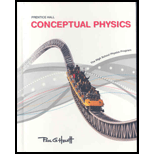
Visualize yourself on a skateboard.
a. When you throw a balk, do you experience an impulse?
b. Do you experience an impulse when you catch a ball of the same speed?
c. Do you experience an impulse when you catch it and theu throw it out again?
d. Which impulse is greatest?

(a)
To identify: Whether an impulse will be experienced or not when a ball is thrown.
Answer to Problem 12A
The person will experience an impulse while throwing a ball.
Explanation of Solution
Introduction:
The impulse momentum which is required to bring the moving object to a stop and then throwing it back again, is more than the impulse needed to just stop the same moving object.
An additional impulse force is required to throw the ball.This is because while throwing the ball, the person applies a force on the ball and on the other hand a force also acts on the person too. This force acting on the person has an impulse.
Conclusion:
Thus, the person experiences an impulse when throwing a ball.
(b)
To identify: Whether an impulse will be experienced or not when a person catches a ball of the same speed.
Answer to Problem 12A
The person experiences an impulse while catching a ball of the same speed.
Explanation of Solution
Introduction:
The impulse which is needed to bring a moving object to a halt and then throwing it again is always higher than the impulse needed for just bringing the object to halt.
Consider the person has to catch a moving ball by his hand, then the person has to an impulse in order to minimize the ball’s momentum to zero.
Hence, the person experiences an impulse while catch a ball of the same speed.
Conclusion:
Thus, the person experiences an impulse while catching a ball of the same speed.
(c)
To identify: Whether an impulse will be experienced or not when a person catches a ball and throw it out again.
Answer to Problem 12A
The person experiences an impulse when catch it and throw it out again.
Explanation of Solution
Introduction:
The impulse which is needed to bring a moving object to a halt and then throwing it again is always higher than the impulse needed for just bringing the object to halt.
Consider a person has to catch the ball and throw it again.
In that case, it requires more impulse to catch the ball and throw it back up than merely to catch it.
Hence, the person experiences an impulse when catching it and throwing it out again.
Conclusion:
Thus, the person experiences an impulse when catch it and throw it out again.
(d)
To identify:The situation when a person will experience greater impulse from part (a), (b) and (c).
Answer to Problem 12A
An impulse when catch it and throw it out again is greater.
Explanation of Solution
Introduction:
The impulse that is required to stop an object and then throw it back again will be greater than the impulse required merely to stop an object.
From part (a), an impulse will be experience by a person while throwing a ball.
From part (b), an impulse will be experience by the person while catching a ball with the same speed.
From part (c), an impulse will be experience by the person while catchinga ball and then throw it out again.
From the above results, it is observed that the impulse provided by the person while catching a ball and then throwing it again is greater.
Conclusion:
Thus, an impulse when catch it and throw it out again is greater.
Chapter 8 Solutions
Conceptual Physics: The High School Physics Program
Additional Science Textbook Solutions
Cosmic Perspective Fundamentals
Human Biology: Concepts and Current Issues (8th Edition)
Anatomy & Physiology (6th Edition)
Organic Chemistry (8th Edition)
Concepts of Genetics (12th Edition)
Microbiology: An Introduction
- please answer this asap!!!!arrow_forwardRT = 4.7E-30 18V IT = 2.3E-3A+ 12 38Ω ли 56Ω ли r5 27Ω ли r3 28Ω r4 > 75Ω r6 600 0.343V 75.8A Now figure out how much current in going through the r4 resistor. |4 = unit And then use that current to find the voltage drop across the r resistor. V4 = unitarrow_forward7 Find the volume inside the cone z² = x²+y², above the (x, y) plane, and between the spheres x²+y²+z² = 1 and x² + y²+z² = 4. Hint: use spherical polar coordinates.arrow_forward
 College PhysicsPhysicsISBN:9781305952300Author:Raymond A. Serway, Chris VuillePublisher:Cengage Learning
College PhysicsPhysicsISBN:9781305952300Author:Raymond A. Serway, Chris VuillePublisher:Cengage Learning University Physics (14th Edition)PhysicsISBN:9780133969290Author:Hugh D. Young, Roger A. FreedmanPublisher:PEARSON
University Physics (14th Edition)PhysicsISBN:9780133969290Author:Hugh D. Young, Roger A. FreedmanPublisher:PEARSON Introduction To Quantum MechanicsPhysicsISBN:9781107189638Author:Griffiths, David J., Schroeter, Darrell F.Publisher:Cambridge University Press
Introduction To Quantum MechanicsPhysicsISBN:9781107189638Author:Griffiths, David J., Schroeter, Darrell F.Publisher:Cambridge University Press Physics for Scientists and EngineersPhysicsISBN:9781337553278Author:Raymond A. Serway, John W. JewettPublisher:Cengage Learning
Physics for Scientists and EngineersPhysicsISBN:9781337553278Author:Raymond A. Serway, John W. JewettPublisher:Cengage Learning Lecture- Tutorials for Introductory AstronomyPhysicsISBN:9780321820464Author:Edward E. Prather, Tim P. Slater, Jeff P. Adams, Gina BrissendenPublisher:Addison-Wesley
Lecture- Tutorials for Introductory AstronomyPhysicsISBN:9780321820464Author:Edward E. Prather, Tim P. Slater, Jeff P. Adams, Gina BrissendenPublisher:Addison-Wesley College Physics: A Strategic Approach (4th Editio...PhysicsISBN:9780134609034Author:Randall D. Knight (Professor Emeritus), Brian Jones, Stuart FieldPublisher:PEARSON
College Physics: A Strategic Approach (4th Editio...PhysicsISBN:9780134609034Author:Randall D. Knight (Professor Emeritus), Brian Jones, Stuart FieldPublisher:PEARSON





